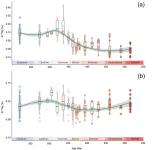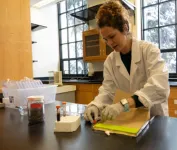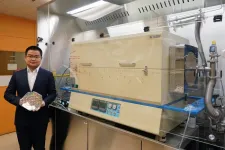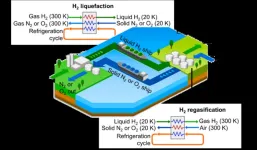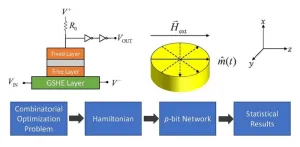(Press-News.org) PHILADELPHIA— A new approach to the genetic engineering of cells promises significant improvements in speed, efficiency, and reduction in cellular toxicity compared to current methods. The approach could also power the development of advanced cell therapies for cancers and other diseases, according to a study from researchers in the Perelman School of Medicine at the University of Pennsylvania.
In the study, which appeared this week in Nature Biotechnology, researchers found that protein fragments used by some viruses to help them get into cells could also be used to get CRISPR-Cas gene editing molecules into cells and their DNA-containing nuclei with extraordinarily high efficiency and low cellular toxicity.
The scientists expect the new technique to be particularly useful for modifying T cells and other cells from a patient’s own body to make cell therapies. One such application could be CAR T (chimeric antigen receptor T cell) therapy, which uses specially modified immune cells from a patient to treat cancer. The T cells—a type of white blood cell—are removed from the patient and reprogrammed to find and attack cancer cells when reintroduced to the bloodstream.
The first FDA-approved CAR T therapy was developed at Penn Medicine, and received Food & Drug Administration approval in 2017. There are now six FDA-approved CAR T cell therapies in the United States. The therapies have revolutionized the treatment of certain B cell leukemias, lymphomas, and other blood cancers, putting many patients who otherwise had little hope into long-term remission.
“This new approach—building on Penn Medicine’s history of cell and gene therapy innovation—has the potential to be a major enabling technology for engineered cellular therapies,” said co-senior author E. John Wherry, PhD, Richard and Barbara Schiffrin President's Distinguished Professor and chair of Systems Pharmacology & Translational Therapeutics at Penn Medicine.
CRISPR-Cas molecules are derived from ancient bacterial antiviral defenses, and are designed to precisely remove DNA at desired locations in a cell’s genome. Some CRISPR-Cas-based systems combine the deletion of old DNA with the insertion of new DNA for versatile genome editing. This approach can be used to replace faulty genes with corrected ones or delete or modify genes to enhance cellular function. Some systems can also add genes that confer new properties to CAR T cells such as the ability to recognize tumors or withstand the harsh tumor microenvironment that normally exhausts T cells.
Although CRISPR-Cas systems are already widely used as standard laboratory tools for molecular biology, their use in modifying patients’ cells to make cell-based therapies has been limited—in part because CRISPR-Cas molecules can be hard to get into cells and then into cells’ DNA-containing nuclei.
“Current methods of getting CRISPR-Cas systems into cells, which include the use of carrier viruses and electric pulses, are inefficient for cells taken directly from patients (called primary cells). These methods also typically kill many of the cells they are used on, and can even cause broad unwanted changes in gene activity,” said co-senior author Shelley L. Berger, PhD, the Daniel S. Och University Professor in Cell and Developmental Biology and Genetics and director of the Penn Epigenetics Institute.
In the study, researchers explored the use of small, virus-derived protein fragments, called peptides, to pilot CRISPR-Cas molecules more efficiently through the outer membranes of primary human cells and into their nuclei. Notably, researchers found that a fused combination of two modified peptides—one found in HIV and one in influenza viruses—could be mixed with CRISPR-Cas molecules to get them into primary human or mouse cells and their nuclei with efficiencies of up to nearly 100 percent, depending on the cell type—with almost no toxicity or gene-expression changes.
The team demonstrated the approach, which they call PAGE (peptide-assisted genome editing), for several types of envisioned cell therapy including CAR T cell therapies.
In addition to its potential use in cell and gene therapies, the authors note the PAGE approach could see wide application in basic scientific research. The inefficiency of standard CRISPR-Cas cell penetration methods has meant that gene-editing to create mouse models of diseases typically requires a multi-step, time-consuming process of generating transgenic mice—to introduce the gene-editing machinery into their DNA. By contrast, PAGE with its high efficiency and low toxicity might enable rapid, efficient, and straightforward gene editing in ordinary lab mice.
“The simplicity and power of the peptide-assist concept suggests that it could potentially be adapted in the future for the delivery into primary cells of other genome-editing proteins, or even protein-based drugs,” said co-senior author Junwei Shi, PhD, an assistant professor of Cancer Biology and member of the Penn Epigenetics Institute and Abramson Family Cancer Research Institute.
The study was a collaboration that included the laboratories of Penn co-author Rahul Kohli, MD, PhD, an associate professor of Infectious Diseases and Biochemistry and Biophysics, and co-author Gerd Blobel, MD, PhD, the Frank E. Weise III Professor of Pediatrics and co-director of the Epigenetics institute.
This study was supported by the National Institute of Health (R01-HL119479, R01-GM138908, AI105343, AI082630, AI108545, AI155577, AI149680, U19AI082630, R35-CA263922, R01-CA258904), the Parker Institute for Cancer Immunotherapy, and institutional funds from University of Pennsylvania.
END
Improved gene editing method could power the next generation of cell and gene therapies
Technique based on special cell-penetrating peptides promises advantages over current methods for editing the genomes of primary cells, such as patients’ T-cells
2023-04-28
ELSE PRESS RELEASES FROM THIS DATE:
ATAD3A: A molecular determinant favoring head and neck cancer development
2023-04-28
“[...] developing targeted therapies that specifically inhibit ATAD3A in cancer cells while sparing normal cells will be a challenging but critical task.”
BUFFALO, NY- April 28, 2023 – A new research perspective was published in Oncoscience (Volume 10) on April 4, 2023, entitled, “Mitochondrial regulator ATAD3A: a molecular determinant favoring head and neck cancer development.”
In addition to their role in energy metabolism, mitochondria play important roles in other cellular processes, such as apoptosis, calcium signaling and the synthesis of certain biomolecules. Mitochondria have also been ...
Vascular plants colonized land extensively by the early Silurian: Study
2023-04-28
The colonization and expansion of plants on land represent a defining landmark for the path of life on Earth. Terrestrial colonization has been attributed to a series of major innovations in plant body plans, anatomy, and biochemistry that transformed global biogeochemical cycles and climates.
It is crucial to identify the onset and track the expansion of those earliest land plants. However, the precise timing of land colonization by vascular plants remains controversial due to the sparseness of early land plant megafossils, poor stratigraphic controls ...
Machine learning helps scientists identify the environmental preferences of microbes
2023-04-28
Researchers have figured out a way to predict bacteria’s environmental pH preferences from a quick look at their genomes, using machine learning. Led by experts at the University of Colorado Boulder, the new approach promises to help guide ecological restoration efforts, agriculture, and even the development of health-related probiotics.
“We know that in any environment, there’s a ton of bacteria with important ecological functions, but their environmental preferences often remain unknown,” said Noah Fierer, a fellow of the Cooperative Institute for Research in Environmental ...
Tianwen-1: Zhurong Rover finds evidence of water at low latitudes on modern Mars
2023-04-28
The Zhurong rover has found evidence of water on dune surfaces on modern Mars by providing key observational proof of liquid water at low Martian latitudes, according to a study led by Prof. QIN Xiaoguang from the Institute of Geology and Geophysics (IGG) of the Chinese Academy of Sciences (CAS).
The study was published in Science Advances on April 28.
Researchers from the National Astronomical Observatories of CAS and the Institute of Atmospheric Physics of CAS were also involved in the study.
Previous ...
Looking for insights from our nearest star-forming galaxy
2023-04-28
Vallia Antoniou, an assistant professor of practice in the Department of Physics and Astronomy at Texas Tech, has been awarded observing time on the powerful Chandra X-Ray Telescope to explore some of the deepest recesses of the universe.
It marks the second major Chandra program led by Antoniou, who is also a research associate with the Smithsonian Astrophysical Observatory.
Each year, astronomers from around the world follow a rigorously competitive process to receive Chandra time. The telescope was launched aboard the space shuttle Columbia in 1999 and orbits Earth, offering previously unavailable views of deep space at wavelengths that are not accessible from ground telescopes. During ...
MIT engineers “grow” atomically thin transistors on top of computer chips
2023-04-28
CAMBRIDGE, MA — Emerging AI applications, like chatbots that generate natural human language, demand denser, more powerful computer chips. But semiconductor chips are traditionally made with bulk materials, which are boxy 3D structures, so stacking multiple layers of transistors to create denser integrations is very difficult.
However, semiconductor transistors made from ultrathin 2D materials, each only about three atoms in thickness, could be stacked up to create more powerful chips. To this end, MIT researchers have now demonstrated a novel technology that can effectively ...
How solid air can spur sustainable development
2023-04-28
The green hydrogen economy is a sustainable alternative to fossil fuels. However, one of the challenges of constructing a global hydrogen economy is hydrogen transportation by sea. A new paper proposes solid air as a medium for recycling cold energy across the hydrogen liquefaction supply chain.
The world is undergoing an energy transition to reduce CO2 emissions and mitigate climate change. The COVID-19 pandemic and the Russia-Ukraine war have further increased the interest of Europe and Western countries to invest in the hydrogen economy as an alternative to fossil fuels. Hydrogen can significantly reduce geopolitical risks ...
Deep-learning system explores materials’ interiors from the outside
2023-04-28
CAMBRIDGE, MA — Maybe you can’t tell a book from its cover, but according to researchers at MIT you may now be able to do the equivalent for materials of all sorts, from an airplane part to a medical implant. Their new approach allows engineers to figure out what’s going on inside simply by observing properties of the material’s surface.
The team used a type of machine learning known as deep learning to compare a large set of simulated data about materials’ external force fields and the corresponding internal structure, and used that to generate a ...
Solving computationally complex problems with probabilistic computing
2023-04-28
According to computational complexity theory, mathematical problems have different levels of difficulty in the context of their solvability. While a classical computer can solve some problems (P) in polynomial time — i.e., the time required for solving P is a polynomial function of the input size — it often fails to solve NP problems that scale exponentially with the problem size and thus cannot be solved in polynomial time. Classical computers based on semiconductor devices are, therefore, inadequate ...
York University leads $318.4M first-of-kind inclusive next-gen technology research initiative
2023-04-28
TORONTO, April 28, 2023 — Is an equitable world that includes humans and machines possible? York University researchers believe it must be and have set out to make it so through a first of its kind interdisciplinary research initiative called Connected Minds: Neural and Machine Systems for a Healthy, Just Society.
From universities to industries, hospitals and policymakers, artists and Indigenous communities, York’s Connected Minds will engage 50+ community partners and research collaborators over seven years supported by a historic $318.4 million in funding. Connected Minds has received a combined $105.7 million from the Canada First Research ...
LAST 30 PRESS RELEASES:
Deep neural networks enable accurate pricing of American options under stochastic volatility
Collective risk resonance in Chinese stock sectors uncovered through higher-order network analysis
Does CPU impact systemic risk contributions of Chinese sectors? Evidence from mixed frequency methods with asymmetric tail long memory
General intelligence framework to predict virus adaptation based on a genome language model
Antibiotic resistance is ancient, ecological, and deeply connected to human activity, new review shows
Vapes, pouches, heated tobacco, shisha, cigarettes: nicotine in all forms is toxic to the heart and blood vessels
From powder to planet: University of Modena engineers forge a low-carbon future for advanced metal manufacturing
Super strain-resistant superconductors
Pre-school health programme does not improve children’s diet or physical activity, prompting call for policy changes, study finds
Autumn clock change linked to reduction in certain health conditions
AI images of doctors can exaggerate and reinforce existing stereotypes
Where medicine meets melody – how lullabies help babies and parents in intensive care
We may never be able to tell if AI becomes conscious, argues philosopher
AI video translation shows promise but humans still hold the edge
Deep ocean earthquakes drive Southern Ocean’s massive phytoplankton blooms, study finds
Without campus leftovers to pick through, the beaks of this bird changed shape during the pandemic
High-dose antibiotic does not reduce mortality in tuberculous meningitis
How many insects fly in the sky above the USA?
Could cheese protect your brain health?
Who faces more difficulty recovering from stroke?
Colliding galaxies create the brightest, fastest growing black holes at their center
New BrainHealth research reveals tradeoffs on sleep with cannabis use for chronic pain
Aging-US now on ResearchGate, enhancing visibility for authors and readers
'Molecular glue' stabilizes protein that inhibits development of non-small cell lung cancer
Mount Sinai Health System is recognized in 2025 Chime Digital Health Most Wired survey
From prey to predator: How carnivores spread beneficial fungi
Menopause symptoms may be frequent and have negative effects, according to female endurance athletes
US Congressmembers’ responses on X to mass shooting events differ along party lines
KAIST-UEL team develops “origami” airless wheel to explore lunar caves
Individual genetic differences render some therapies ineffective
[Press-News.org] Improved gene editing method could power the next generation of cell and gene therapiesTechnique based on special cell-penetrating peptides promises advantages over current methods for editing the genomes of primary cells, such as patients’ T-cells

